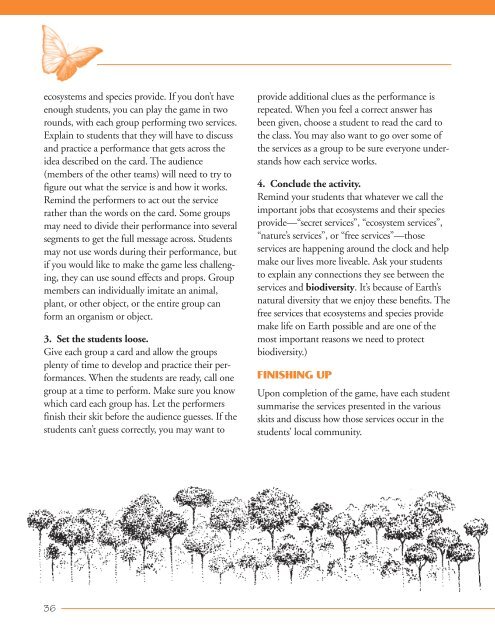EXPLORING BIODIVERSITY: A Guide for Educators Around the World
EXPLORING BIODIVERSITY: A Guide for Educators Around the World
EXPLORING BIODIVERSITY: A Guide for Educators Around the World
You also want an ePaper? Increase the reach of your titles
YUMPU automatically turns print PDFs into web optimized ePapers that Google loves.
ecosystems and species provide. If you don’t have<br />
enough students, you can play <strong>the</strong> game in two<br />
rounds, with each group per<strong>for</strong>ming two services.<br />
Explain to students that <strong>the</strong>y will have to discuss<br />
and practice a per<strong>for</strong>mance that gets across <strong>the</strong><br />
idea described on <strong>the</strong> card. The audience<br />
(members of <strong>the</strong> o<strong>the</strong>r teams) will need to try to<br />
figure out what <strong>the</strong> service is and how it works.<br />
Remind <strong>the</strong> per<strong>for</strong>mers to act out <strong>the</strong> service<br />
ra<strong>the</strong>r than <strong>the</strong> words on <strong>the</strong> card. Some groups<br />
may need to divide <strong>the</strong>ir per<strong>for</strong>mance into several<br />
segments to get <strong>the</strong> full message across. Students<br />
may not use words during <strong>the</strong>ir per<strong>for</strong>mance, but<br />
if you would like to make <strong>the</strong> game less challenging,<br />
<strong>the</strong>y can use sound effects and props. Group<br />
members can individually imitate an animal,<br />
plant, or o<strong>the</strong>r object, or <strong>the</strong> entire group can<br />
<strong>for</strong>m an organism or object.<br />
3. Set <strong>the</strong> students loose.<br />
Give each group a card and allow <strong>the</strong> groups<br />
plenty of time to develop and practice <strong>the</strong>ir per<strong>for</strong>mances.<br />
When <strong>the</strong> students are ready, call one<br />
group at a time to per<strong>for</strong>m. Make sure you know<br />
which card each group has. Let <strong>the</strong> per<strong>for</strong>mers<br />
finish <strong>the</strong>ir skit be<strong>for</strong>e <strong>the</strong> audience guesses. If <strong>the</strong><br />
students can’t guess correctly, you may want to<br />
provide additional clues as <strong>the</strong> per<strong>for</strong>mance is<br />
repeated. When you feel a correct answer has<br />
been given, choose a student to read <strong>the</strong> card to<br />
<strong>the</strong> class. You may also want to go over some of<br />
<strong>the</strong> services as a group to be sure everyone understands<br />
how each service works.<br />
4. Conclude <strong>the</strong> activity.<br />
Remind your students that whatever we call <strong>the</strong><br />
important jobs that ecosystems and <strong>the</strong>ir species<br />
provide—“secret services”, “ecosystem services”,<br />
“nature’s services”, or “free services”—those<br />
services are happening around <strong>the</strong> clock and help<br />
make our lives more liveable. Ask your students<br />
to explain any connections <strong>the</strong>y see between <strong>the</strong><br />
services and biodiversity. It’s because of Earth’s<br />
natural diversity that we enjoy <strong>the</strong>se benefits. The<br />
free services that ecosystems and species provide<br />
make life on Earth possible and are one of <strong>the</strong><br />
most important reasons we need to protect<br />
biodiversity.)<br />
FINISHING UP<br />
Upon completion of <strong>the</strong> game, have each student<br />
summarise <strong>the</strong> services presented in <strong>the</strong> various<br />
skits and discuss how those services occur in <strong>the</strong><br />
students’ local community.<br />
36

















